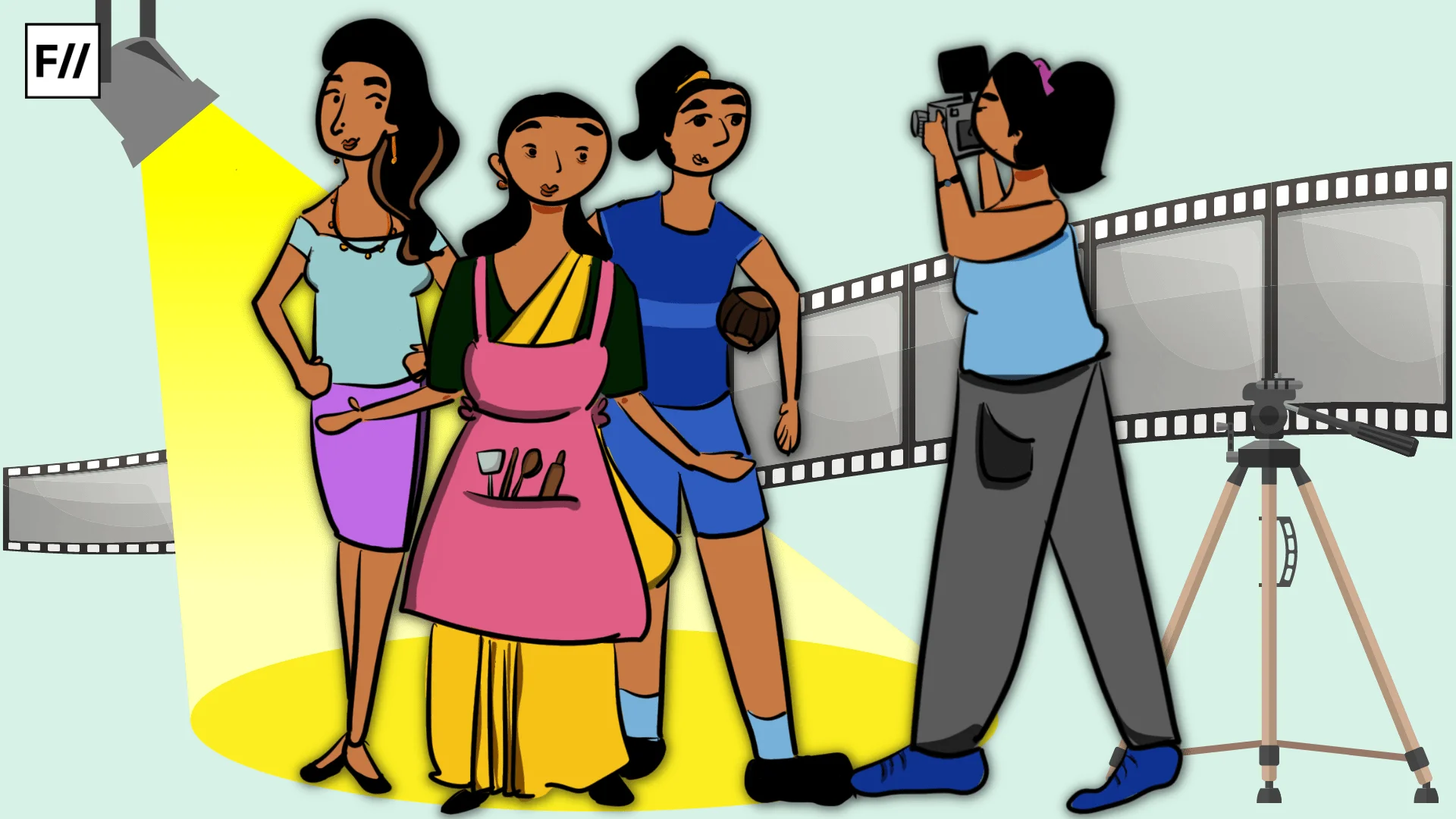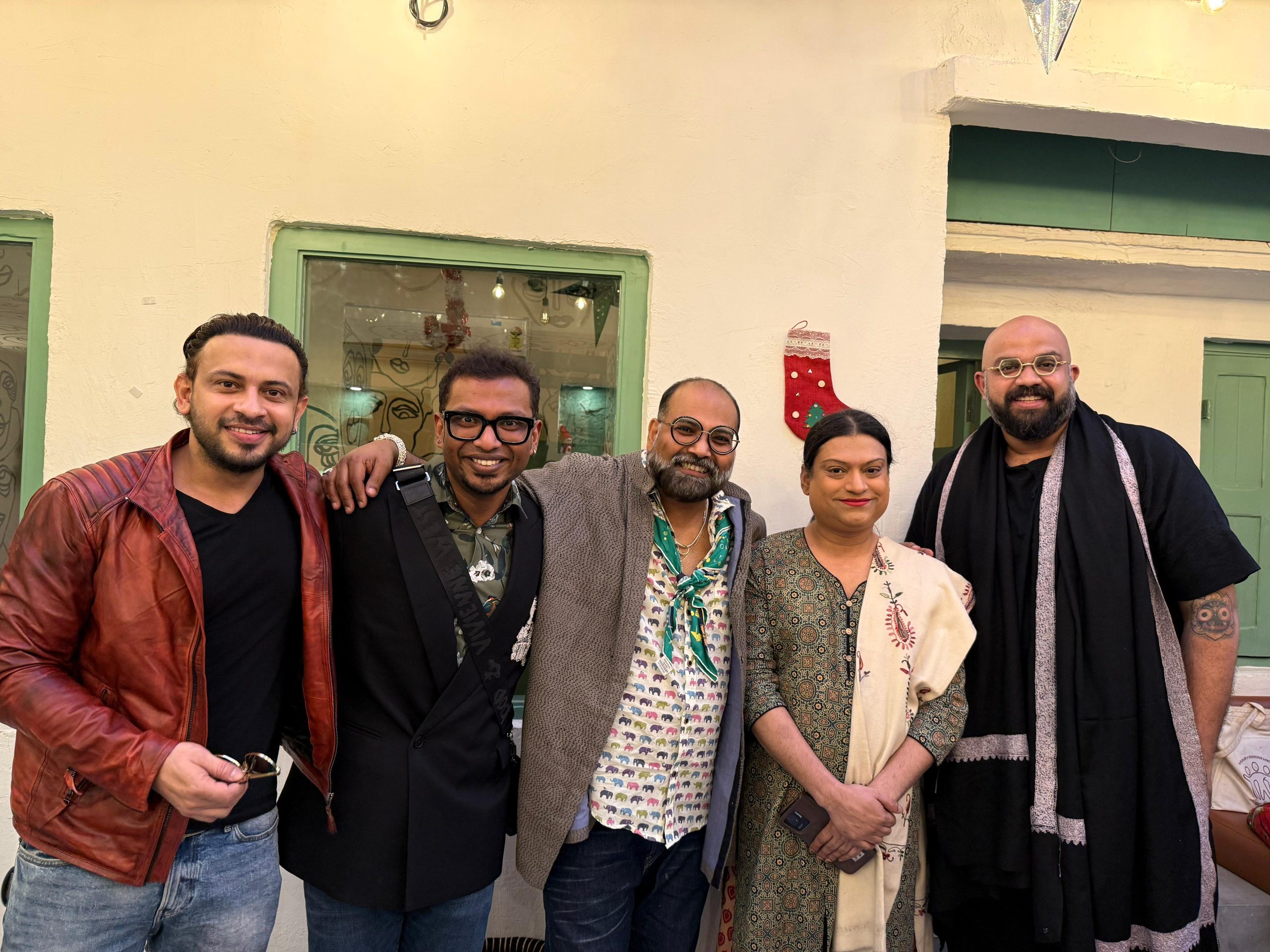The term tradwife has recently gained traction in the Indian context, and the Cambridge Dictionary just recognised the term, defining it as ‘a married woman, especially one who posts on social media, who stays at home doing cooking, cleaning, etc. and has children that she takes care of.’ ‘Tradwife’ is short for traditional wife. As a researcher who has been working on studying this phenomenon of Indian women choosing to perform household chores on social media, this does not come as a shock. As a part of my research, I have been tracking this phenomenon for my thesis over three platforms, namely YouTube, Instagram, and Facebook. The idea that we have been consuming content that pitches cooking for one’s partner, family members, doing household chores, and taking care of children is not new, but surely does challenge a lot of feminist debates on reproductive labour and the private sphere.
Trad wives are not just women performing reproductive labour but also recording and visibilising this lifestyle on social media. Social media acts as an infrastructure that facilitates the monetisation of this labour, which complicates feminist debates about women having to bear the burden of performing reproductive labour that does not produce ‘value’ and is limited to the private sphere. With the advent of this phenomenon, the ‘private’ sphere is now made open for the ‘public’, blurring the public-private dichotomy that is so central to the feminist debates.

With the monetisation of ‘reproductive’ labour, it also holds the potential to convert it into ‘productive’ labour again, muddying assumptions that are so central to the camp of feminist political economy. Through this article, I attempt to understand the phenomenon and not necessarily critique it because the category of the ‘tradwife’ does not entirely apply in the Indian context and adopting this term would lead to an acultural (Taylor, 1999) analysis of the phenomenon unfolding in India.
Submission or strategy? Contrasting tradwife ideology with Indian food influencer entrepreneurship
Recent scholarship highlights the rise of the tradwife phenomenon in Euro-American contexts, particularly on platforms like TikTok, where cisgender women embrace and promote patriarchal gender norms under the banner of “traditional femininity” (Scott & Day, 2025). Tradwife influencers position themselves as stay-at-home wives and mothers who derive fulfilment through domesticity, submission to husbands, and rejection of feminist ideals. As Scott and Day (2025) show, the tradwife aesthetic is deeply intertwined with biblical references (Ephesians, Genesis, Proverbs) and a racialised nostalgia for white, Christian, heteronormative family structures. This content not only romanticises a return to mid-twentieth-century domestic ideals but also functions as a conduit for far-right, anti-feminist, and even white nationalist discourses, where women’s subservience is framed as both spiritual duty and cultural preservation.
Tradwife influencers position themselves as stay-at-home wives and mothers who derive fulfilment through domesticity, submission to husbands, and rejection of feminist ideals. Recent scholarship highlights the rise of the tradwife phenomenon in Euro-American contexts, particularly on platforms like TikTok, where cisgender women embrace and promote patriarchal gender norms under the banner of “traditional femininity”
By contrast, Indian women who monetise domesticity and care on digital platforms present a distinctly different narrative. Figures such as Kabita Singh (@Kabita’s Kitchen) or Sahini Banerjee (@Feashts) do not frame themselves as submissive wives or biblical homemakers, nor do they advocate a withdrawal from the marketplace. Instead, they explicitly position themselves as entrepreneurs, content creators, cultural archivists, and home cooks rather than chefs. Their labour of cooking, documenting recipes, and curating age-old food traditions is deployed as a business strategy that transforms undervalued household knowledge into an aspirational digital product. The emphasis is not on wifely subordination but on individual enterprise and the construction of a professional, individual brand.

Whereas tradwives cloak digital entrepreneurship in the language of religious subservience, many Indian influencers highlight transparency in their monetisation practices—renting studios, building aesthetic sets, and openly marketing their channels as businesses. They do not necessarily depend on their partners or promote being a subservient and dutiful wife. Instead, they pride themselves on acquiring skills and building a brand of their own, often without the help of their partners. In contrast to the Western tradwife phenomenon that has been popularised by Estee Williams and Hannah Neeleman (popularly known as the @ballerinafarm), many of these content creators also share videos dividing household labour with their partners.
For example, Shahini Banerjee is seen with her husband, Sunny, cooking meals for each other. We also see ‘shared diaries’ by @WowPooja showcasing her life with her partner, sharing household responsibilities. She is also seen performing household chores before and after her 9-5 ‘productive’ job, documenting how a woman’s job is never done. Therefore, the tradwife phenomenon of the West does not neatly fit the monetisation of household labour that is prevalent in the Indian context.
A good Christian wife versus a Sanskari Bahu: two sides of the same coin
Another significant divergence lies in the axes of religion and ideology. While Western tradwife influencers consistently invoke Christian scripture to naturalise women’s subservience (Scott and Day, 2025), Indian domestic influencers do not anchor their content in comparable religious frameworks. Rituals and festivals may appear, but largely as cultural heritage rather than as evidence of women’s divinely ordained duty to men. The Indian case, therefore, lacks the overt anti-feminist ideology that underpins the tradwife phenomenon but reframes this practice as ‘choice feminism’. Instead, women online mobilise domesticity as a form of aspirational labour (Duffy, 2015), presenting themselves as digital entrepreneurs who extract value from historically feminised and devalued labour.
The Indian context is not free of exclusionary dynamics. Just as the tradwife phenomenon is marked by racial and class privilege, Indian food and homemaking influencers are shaped by caste and class stratifications. The ability to rent studios, access high-end appliances, or curate minimalist, aestheticised kitchens is often limited to upper-caste, upper-class women.
However, the Indian context is not free of exclusionary dynamics. Just as the tradwife phenomenon is marked by racial and class privilege, Indian food and homemaking influencers are shaped by caste and class stratifications. The ability to rent studios, access high-end appliances, or curate minimalist, aestheticised kitchens is often limited to upper-caste, upper-class women.
For example, Oman Gupta refers to herself as a “bania bahu”, showcasing her life as a “20-year-old married woman”. Being explicit about her caste, she claims, gets her a bigger reach in terms of her audience. She feeds off the critique she receives in her comments from women because that increases her viewer engagement, she told Scroll.
Then we have creators like Japneet Sethi, who is by profession a makeup artist but is often seen making videos around the trope ‘a day in the life of a 22-year-old married woman‘. She also goes on to say that she is living a privileged life without focusing on her career, as she has ‘four to five maids at her home all the time‘. This renders invisible the everyday domesticity of working-class waged domestic workers, often belonging to lower castes, whose labour continues to be performed in private households or as waged domestic work, rarely celebrated as cultural capital.
In this case, while Indian digital homemakers resist the tradwife script of subservience, they reproduce a different form of privilege that makes their entrepreneurial domesticity legible and aspirational primarily for middle- and upper-class audiences.

In short, while both the tradwife movement and Indian domestic influencers centre the home and domestic labour, their logics diverge. Tradwife content is ideologically orientated, promoting anti-feminist, religiously inflected subservience to men and reinscribing whiteness as cultural capital in the Western context. Indian domestic influencers, on the other hand, mobilise domesticity as a market-facing, entrepreneurial practice, aligning more with survival strategies in precarious economies than with religious traditionalism in many cases. Yet, both cases are structured by privilege—race and religion in the Western case, caste and class in the Indian—underscoring how domesticity on social media is never a neutral terrain but always embedded in broader hierarchies of power.
Expanding Jarrett’s Notion of Women’s Work: From Use-Value to Exchange-Value
Kylie Jarrett (2014) argues that “women’s work”, domestic, affective, and reproductive labour, has always occupied a contradictory position in capitalist economies. Such labour is indispensable because it produces ‘use value’, such as nourishment, care, and socialisation, thereby sustaining the labour force and reproducing the conditions of production. Yet it has traditionally been excluded from the realm of recognised economic activity because it did not directly generate ‘exchange value’.
Drawing on Fortunati (1995), she explains that women’s reproductive work has historically been rendered invisible or naturalised, and its contribution to capitalist accumulation has been indirect and misrecognised. Feminist debates around the misrecognition of social reproductive labour on which capitalist infrastructures rely to accumulate surplus value indicate that it has led to maldistribution in terms of ‘life-making’ activities (Fraser, 2016; Bhattacharya, 2017) being uncompensated.
In the context of social media, however, the dynamics Jarrett (2104) describes are transformed. When Indian women curate kitchens to be aesthetically pleasing, stage household chores, or present themselves as “good housewives” online, they are not only producing social value but also creating digital commodities for consumption.
Abidin (2016) describes this as “visibility labour”. “Visibility labour is the work individuals do to sustain their online presence, render themselves visible, and engage with visibility practices in ways that are considered favourable, valuable, and legitimate within digital cultures” (Abidin, 2016: 5). She also goes on to state that “such labour is affective, embodied, and aestheticised, requiring influencers and followers alike to constantly calibrate their self-presentations to resonate with audiences, platforms, and brands” (Abidin, 2016: 6). In such cases, what Jarrett identifies as reproductive labour’s indirect role in capitalism acquires a new dimension. When performed on social media, reproductive labour that is also ‘visibility labour’ (Abidin, 2016) explicitly produces exchange value as it attracts followers, sponsorships, and advertising revenue, while also feeding platform logics of engagement and data extraction.
Expanding Jarrett’s framework highlights the shifting boundaries of “women’s work” under digital capitalism. Care and domestic labour, once confined to the private sphere and valued only for their reproductive use, have now become directly commodified when mediated by digital infrastructures.
In Oman Gupta’s viral “bania bahu” reels, for example, the performance of domestic roles mobilises caste and gendered scripts to generate visibility and monetisation. Similarly, Sahini Banerjee’s “Welcome to the Midnight Café” transforms late-night cooking into kawaii-styled content that circulates as both aesthetic pleasure and marketable commodity. In these cases, women’s reproductive labour not only sustains social relations but is actively enrolled into capitalist accumulation, collapsing the distinction between use-value and exchange-value.
Digital nostalgia and conservative futures: Tradwives supporting broligarchs
The recent recognition of the term tradwife by the Cambridge Dictionary, alongside ‘broligarch’, reveals two sides of an emerging cultural landscape shaped by both digital performance and political conservatism. While tradwife refers to women who embrace and promote highly gendered domestic roles online — celebrating homemaking, nurturing, and submission as aspirational — broligarch captures the hyper-masculine, wealthy male influencer archetype. These terms are not neutral descriptions of internet trends; their institutional recognition signals how digitally mediated identities are being normalised and legitimised.
Importantly, the tradwife phenomenon is more than a performance of household labour. It operates as a conservative push to return to the “good old days”, when women were primarily responsible for care, reproduction, and moral guidance, often at the expense of their autonomy in public and economic life. In contrast, the broligarch embodies the accumulation of power, capital, and entitlement, relying on the silent labour of women to sustain his authority. Together, they exemplify a gendered ecosystem of digital conservatism that reinscribes old hierarchies under the guise of modern lifestyle choices.
This cultural shift cannot be dismissed as “cringe content” but must be read against the backdrop of political economies and resurgent right-wing conservatism in both the West and India. In India, for instance, the state has amplified such currents by officially recognising digital creators through initiatives like the National Creators Day Awards. These gestures encourage young women to imagine the digital public sphere rather than workplaces or political arenas as their site of visibility and influence. Given the persistent lack of employment opportunities and the dangers of women’s participation in the physical public sphere, the internet becomes a safer, though still precarious, alternative.
Yet this apparent empowerment sits uneasily alongside the masculinist cultures of the manosphere (Scott & Day, 2025), where the tradwife is positioned as the supportive counterpart to the broligarch. As Scott and Day (2025) argue in their work on the manosphere, this alignment is not accidental: it produces a mutually reinforcing cultural script where women’s care and submission are necessary conditions for the flourishing of male dominance. The recognition of such terms by mainstream institutions, therefore, reflects not just digital slang but a broader cultural endorsement of reactionary gender politics.
References
- Abidin, C. 2016. Visibility labour: Engaging with Influencers’ fashion brands and #OOTD advertorial campaigns on Instagram. Media International Australia, 161(1), 86-100. https://doi.org/10.1177/1329878X16665177
- Taylor, Charles. “Two Theories of Modernity.” Public Culture, vol. 11, no. 1, 1999, pp.
153–174. - Duffy, Brooke Erin. 2015. “Amateur, Autonomous, and Collaborative: Myths of Aspiring
Female Cultural Producers in Web 2.0.” Critical Studies in Media Communication, vol.
32, no. 1, pp. 48–64. - Duffy, Brooke. Erin. 2017. Not getting paid to do what you love: Gender, social media,
and aspirational work. Yale University Press. - Fortunati, L. 1995. The Arcane of Reproduction: Housework, Prostitution, Labour and Capital. Translated by Hilary Creek. New York: Autonomedia.
- Fortunati, L. 2007. “Immaterial Labor and Its Machinization.” Ephemera 7 (1): 139–57.
- Jarrett, Kylie. 2013. The Relevance of “Women’s Work”: Social Reproduction and Immaterial Labor in Digital Media. Television & New Media, 15(1), 14-29. https://doi.org/10.1177/1527476413487607 (Original work published 2014)
- McRobbie, Angela. 2008. The Aftermath of Feminism: Gender, Culture and Social
Change. London: SAGE Publications. - Rottenberg, Catherine. 2018. The Rise of Neoliberal Feminism. Oxford: Oxford
University Press. - Scott, Kate, and Lindsay Day. “TikTok Tradwives: Femininity, Reproduction, and Social
Media.” Gender Education, Aug. 2025. Taylor & Francis Online.
About the author(s)
Sneha Roy is a PhD Student at the Geneva Graduate Institute. Her work looks at the intersection between capitalism and feminism, studying the burgeoning phenomenon of neoliberalised versions of feminism.




